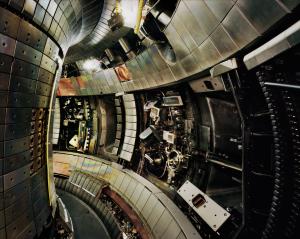An almost religious entanglement
1 Apr 2011
-
Sabina Griffith
Thomas Struth: Tokamak Asdex Upgrade Interior 2, Max Planck IPP, Garching, 2009. Chromogenic print, 141,6 x 176,0 cm. © 2011 Thomas Struth
If you happen to pass through the German town of Düsseldorf in the next days or weeks, make sure that you reserve some time for a visit to the Kunstsammlung Nordrhein-Westfalen, North-Rhine Westphalia's contemporary art collection. Fascinated by "the innards of the machines that manufacture the future," the Düsseldorf-based artist Thomas Struth is currently exposing some large-format photographs of Asdex Upgrade, the tokamak based at the Institute for Plasmaphysics in Garching.
Struth is among the most important representatives of contemporary German photography. Born in 1954, his wide-ranging work includes depictions of detailed cityscapes, Asian jungles and family portraits. Along with Andreas Gursky, he is one of Germany's most widely exhibited and collected fine art photographers. His work has been widely shown in solo and group exhibitions, among them the Venice Biennale, the Documenta IX at Kassel, the Institute of Contemporary Arts and the Tate Collection in London, and the Metropolitan Museum of New York. In 2007, he became the first contemporary artist ever to be exhibited at the Museo del Prado, Madrid, amidst the permanent collection of old masters.
So what leads an artist from shooting family portraits to the sober technology of a plasma chamber? "One day, on an airplane, I read an article about fusion and I found myself both fascinated and shocked by the complexity of this endeavor. I asked myself whether mankind will be happier in the future through technological achievements like this, a thought that now, after the disaster happening in Japan, has become even more urgent. But knowing about the long timescales fusion scientists have been working with, I wanted to see and understand why they get as entangled as they do. To get this entangled, they have to really believe in something in almost a religious way. So what I am showing in my images is the entanglement and the intensity, and the forgetting of everything else."
The exhibition is open until 19 June 2011. Additional venues are London (Whitechapel Gallery, 6 July-16 September 2011) and Porto (Museu Fundação Serralves, 14 October 2011-29 January 2012).


